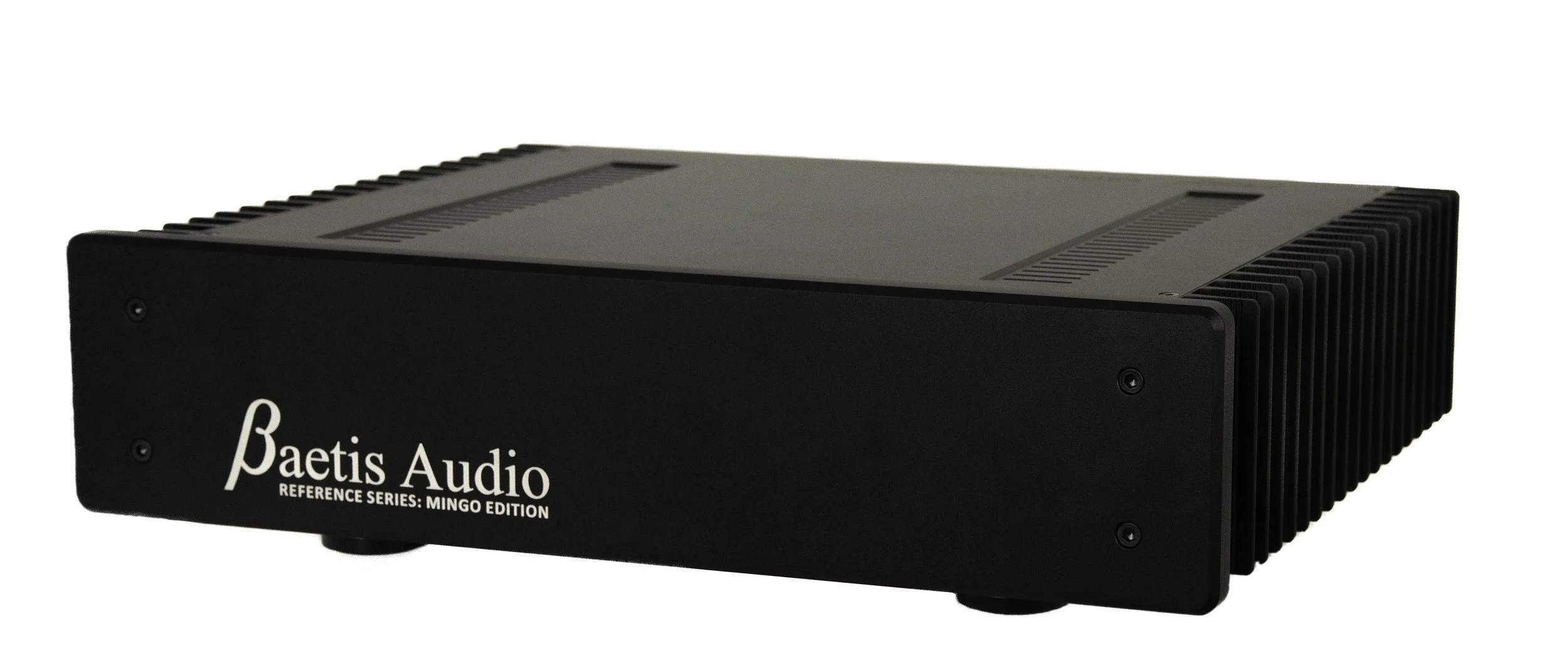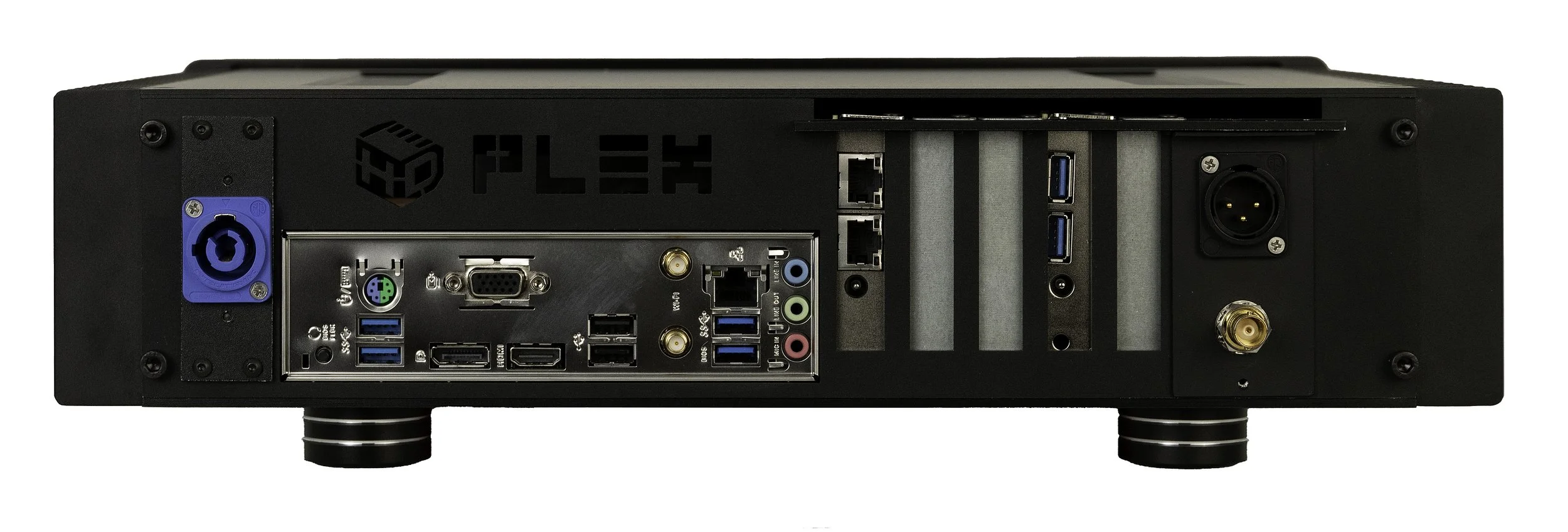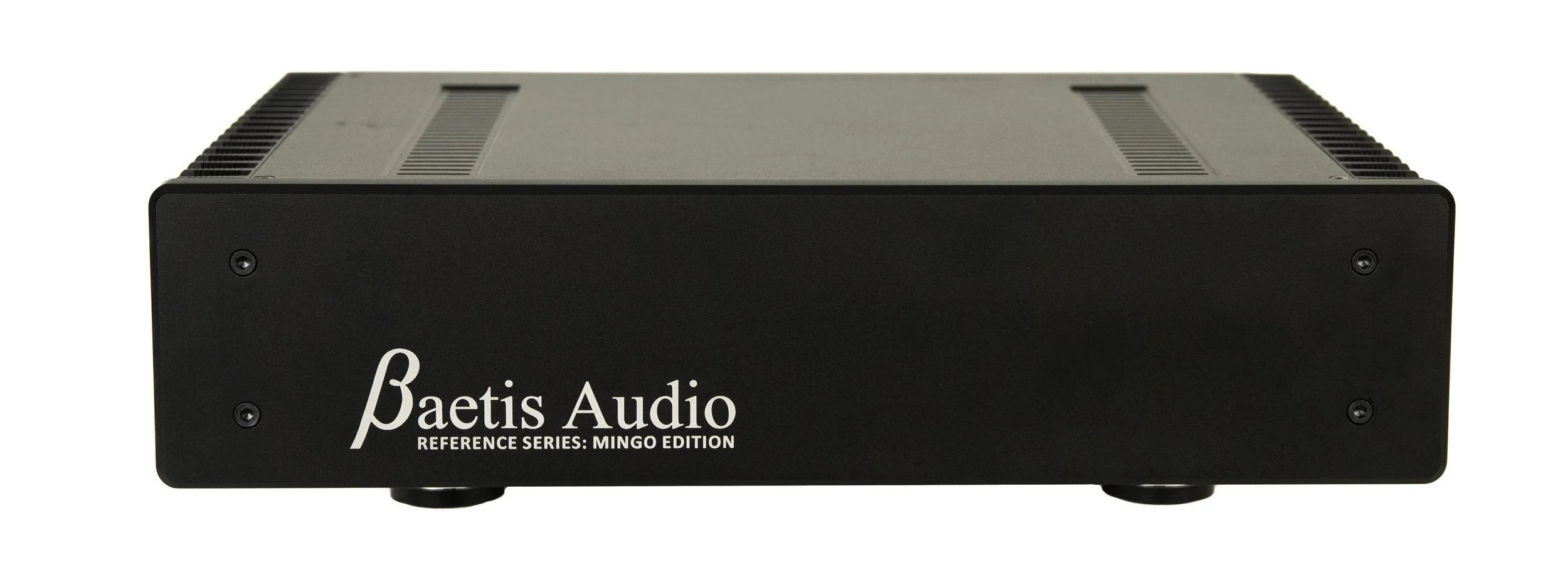BAETIS AUDIO REFERENCE 4 MINGO STREAMER - REVIEW
BAETIS AUDIO REFERENCE 4 MINGO STREAMER
Over the past several weeks, I’ve been to two jazz concerts. The first concert, at the Dakota in downtown Minneapolis, featured the Kavyesh Kaviraj Quintet, a jazz ensemble. The second concert was Pat Metheny’s Dream Box tour at the Ordway in St. Paul. Well, there’s nothing like live music…almost.
The first concert, with the Kavyesh Kaviraj Quintet, featured Kavyesh on piano with Omar Abdulkarim on trumpet, Kevin Washington on drums, Jeff Bailey on bass, and Pete Whitman on saxophone. While the music was promising, the mix of the instruments was at best troubling. The drummer was way too high in the mix and was literally overpowering everyone else. It was as if a rock drummer had sat in with a jazz ensemble and believed himself to be in a stadium. And though the trumpet and the saxophone were not nearly as high in the mix as the drums, collectively they completely overpowered or “mugged” the pianist. Kavyesh’s piano had become an afterthought in the music, a bit player in his own ensemble. I strained to even get glimpses of the piano, despite being several feet from the stage, and this was exceedingly frustrating.
At one point, early in the concert, when Kavyesh rose from his piano to engage with the audience, I raised my hand. When Kavyesh acknowledged me, I said, “Excuse me, but your piano is way too low in the mix and the drums and horns are way too high. I cannot hear your piano.”
Kavyesh nodded his thanks and immediately motioned to the mixing board to bring his piano way up in the mix above the “supporting” cast. From that point on, the concert went exceedingly well, and I was thanked here and there by concert-goers who no doubt felt the same way.
The Pat Metheny concert at the Ordway promised a great show from an exceptionally talented guitarist, whom I’ve followed from his New Chataqua (1979) album to the present. I have many favourites among his discography, though one of my very favourites is his Beyond the Missouri Sky album, with the late bassist Charlie Haden. This album tells a beautiful story, from beginning to end, by two superb musicians.
The concert saw Metheny perform solo and on no fewer than half a dozen guitars and other, well, instrumental contraptions, as the performance approached its end. There were the well known long-time favourites, which were well played, but a solo guitar cannot and did not make up for the lack of bass accompaniment, or drums, or horns, etc. And in a darkly lit theatre, seated in a comfy chair listening to the mellifluous and comforting notes strummed on Pat’s guitar, the “drifting-off-to-sleep” cherub armed with bow and arrow was relentless. Suffice to say, there was a good deal of pre-somnolent head-bobbing and forearm slippage from the arms of my comfy chair. In other words, the concert did not maintain my rapt attention.
When, for instance, has the “featured” instrument ever been buried, unheard, beneath the mix in your recorded music? When has a concert lured you into the throes of dreamland? Imagine that! Hmmmm, all live concerts are not created equal and there are times, no doubt, when your stereo system provides for a better, more engaging overall performance than a live concert. Note to Mr. Metheny: you’ll probably want an ensemble with you from here on out. Just saying…
This brings me to the review of a superb streamer in the form of the Baetis Audio Reference 4 Mingo, which apparently has the ability to actually provide exceptional performances, time after time (see Pat Metheny’s Dream Box).
REFRAIN: Unlike most reviews, this review will be non-sequential, as it will start with how the headphones actually sound and not the process of physically “undressing” them and/or laying out their various parts, specifications, etc. Think of this review, then, as a non-linear movie—Memento, Kill Bill, Arrival, Eternal Sunshine of the Spotless Mind, etc.—that likewise starts at the end and winds its way to the beginning.
The SYSTEM
Baetis Audio Revolution X4 Streamer
Silent Angel Rhein Z1 Plus Streamer
Silent Angel Forester F2 Linear Power Supply (LPS)
Silent Angel Bonn N8 Network Switch
Mola Mola Tambaqui DAC
Mojo Audio Mystique X SE DAC
Dan Clark CORINA Electrostatic Headphones
STAX SR-009S Electrostatic Headphones
Blue Hawaii SE Electrostatic HPA
Kubala Sosna Cables/Wires/Power Cords
Black Cat TRØN Signature Digital Cable
TORUS RM20 Power Conditioner
The Sound
Alive! Alluring. Eminently musical. Whereas its sibling— Baetis Audio Revolution X4—unfolded a profound naturalness, “shoulder-dropping analog quality,” exceptional transparency and sweetness, the Reference 4 Mingo easily and quickly surpassed all that the Revolution X4 brought to bear. The Reference 4 Mingo is nothing less than alive, with technical wherewithal—transparency, resolution, staging abilities—and a beautifully refined musicality that are outstanding.
There are a lot of “mores” when it comes to the Baetis Audio Reference 4 Mingo. For instance, there is more atmosphere, reminiscent of a live performance, more dimensionality, which speaks to the truth of a given soundstage. There is also a more natural perspective on any given performance, and “more” or better articulation of spoken word and lyrics. There is a poignancy, call it refinement, that allows for the most minute details, microdynamics, as allied to position and movement, to tone and timbre, that reveal note and lyric delivery as crystal clear and “alive.” The Reference 4 Mingo’s distributed signal is also imbued with a weight and solidity that conjures a lifelike palpability.
The only other time the music became this real, this present, and in room was with the Grimm Audio MU1 coupled to the Mola Mola Tambaqui. When a 40-year favourite—Miles Davis, Kind of Blue—is more real, more alive, and Paul Chambers’ upright bass is more transparent, detailed, and possessed of a new level of engagement, something rather profound has occurred. When one considers the various systems, some in the six figures, that have played back this album, CD, or its digital stream, that is saying something.
No, the $25K streamer that shall not be named never came close, was not even on the same continent in terms of overall performance, nor for that matter was the $18K streamer. They came a distant second and third respectively to the Reference Mingo’s much less expensive sibling—Baetis Audio Revolution X4 ($6,000). What the Baetis Audio Reference 4 Mingo did to them is therefore unmentionable in mixed company.
The “Blatt” of horns via the Reference 4 Mingo is more “Blatt” than it has ever been. And Jimmy Cobbs’s brushes across drum skins, the tap, tap, tap of drumsticks on rims or teasing out cymbals or bearing down on drum skins were exceptional. Bill Evans’ piano came with a weight and drive and tonal/timbral accuracy that easily summoned “alive,” as in a live performance. Palpability as such was not piecemeal, existing here or there, pertaining to this instrument or that—it was ubiquitous. And underneath it all, the weight and gravitas and effervescent highs were together evocative of that same live performance and brimming with atmosphere, atmosphere, atmosphere!
In my review of the Baetis Audio Revolution X4, I alluded to analog and how well the Revolution X4 recreated the sense—the shoulder-dropping ease and its magnetic listenability. The Reference 4 Mingo goes further still and in every respect with the aforementioned transparency and detail that takes analog to a higher level of refinement, nuance, and naturalness, which together, again, say “alive.”
Ahhh, and herein lies the peril of reviewing audio equipment and especially in this age of rapid technological improvements. There is always the distinct possibility that you will encounter a more talented, more capable audio component that will surpass the benchmark set by the previous best, seemingly, moments ago. The Reference 4 Mingo dispatched its little brother, as its little brother had dispatched the much more expensive streamers that shall not be named. They—that shall not be named—were sent home to their respective manufacturers, never to be reviewed or ever again mentioned. We don’t throw poor performing products under the bus, nor do we mention them by name, thereafter.
The Baetis Audio Reference 4 Mingo’s volumetric cube—its soundstage—is truly encompassing. In a like configuration to the Grimm MU1 and the Mola Mola Tambaqui via an AES/EBU digital link, the Reference 4 Mingo and the Mola Mola Tambaqui were transcendent. The soundstage was broad and deep, falling well beyond the placement of the speakers. The staging via the duo provided rock-solid positioning, with separation and layering giving distinct spatial representation that was nothing less than superb. Whereas its sibling was outstanding in respect to soundstaging, the Reference 4 Mingo was extraordinary and more textured, more dynamic, and more real.
[Note: The best results were consistently achieved with the Mola Mola Tambaqui, though truly exceptional results were also achieved with the Bricasti Design M1.]
Bass
The bass of the Reference 4 Mingo was tighter, more resolute, the dynamic contrasts more beautifully differentiated, and the microdynamics/transient response via the Reference 4 Mingo were blistering. The talents that the Baetis Audio Revolution X4 had so acutely demonstrated with regard to the bass frequency region, the Reference 4 Mingo eclipsed. The Reference 4 Mingo laid bare not only the form or presence of an instrument but the interaction and dexterity of bassists, from Dave Holland to Ray Brown to Charles Mingus to Charlie Haden, was easily followed and beautifully captured. And the Reference 4 Mingo’s tonal/timbral shadings (“colours”) were more from a box of 120 crayons as opposed to the Revolution X4’s 64 crayons or other streamers’ 24 crayons.
It also became apparent that while the Revolution X4 easily lifted away veils that had denied the other streamers greater transparency and resolution, its own veils remained. The Reference 4 Mingo highlighted its sibling’s veils and lifted them away with consummate ease, time and time again. The music, now free of any residual opacity, was astonishingly textured and natural.
There is a weight and impact never before realized by the Meze Empyreans, or the Abyss AB1266 Phi TC headphones, or the Vivid Audio Kaya 45s in the various Reference systems. This can be immediately attributed to the Baetis Audio Reference 4 Mingo streamer, as everything else remained exactly the same.
Midrange
A beguiling musicality arose from the Mingo’s deep transparency, its superb resolution, and relentless detail retrieval, that together were more than reminiscent of exceptional analog. I would go further and say that the Reference 4 Mingo would sit easily beside an exceptional analog rig and lose very little, if anything at all via the comparison.
The Mingo’s midrange abilities with regard to vocals—the delivery of spoken word and lyric—with regard to phrasing, articulation, delivery, are easily more intelligible, more accessible, more poignant, natural, and immersive. Perhaps this is one of the ways it lines up so well and easily with analog.
Case in point: Rickie Lee Jones' eponymous album and Joan Shelly’s eponymous album are delivered like they have never been delivered before. Every word is more clear and more clearly understood, and the guessed-at words are laid bare. Tens, if not hundreds of listenings, and these albums have never sounded better. Suffice to say that there is even more there there with the Baetis Audio Reference 4 Mingo.
Treble+
Alive! Energetic. Beautifully extended. As I had done with the Baetis Audio Revolution X4 Mingo, I once again bring out several well-known treble pieces to understand the Revolution X4 Mingo’s abilities relative to its sibling and to the various other streamers that had made the cut and those that had not.
Hilary Hahn’s “Chaconne from Partita No. 2 for Violin in D minor, BWV 1004” (The Essential Hilary, Sony Classical) is immediately more transparent and energetic and bears greater weight via the Reference 4 Mingo. The Reference 4 Mingo reveals this, once again, through greater transparency, the interplay of the violin’s strings, the bowing, the violin’s external body and the resonances in its internal cavity, unlike it has ever been portrayed before.
On Gidon Kremer’s “Preghiera” (Rachmaninoff: Piano Trios, Deutsche Grammophon), the background comes to life like it has not before, exposing a violin and a cello that had scarcely been there, if at all. The Reference 4 Mingo brought this combo from beyond the veil of an obscurant opacity to life via crystalline transparency. Only the Grimm Audio MU1 was equal to the task.
Dave Brubeck's “Take Five” (Time Out, Columbia-Legacy) rolls in and Joe Morello’s drum kit, its cymbals are energetic, beautifully resolved, and “air-infused.” Together these attributes project a palpable presence that is captivating and wonderfully three-dimensional, with atmosphere to spare. Eugene Wright’s bass no longer hides in the background as an underrepresented “thump thump,”—it too is more three-dimensional, with more gravitas, weight, and presence. Bravo.
WRAPPINGS, Design—Look, Feel
The Baetis Audio Reference 4 Mingo, like its sibling, comes in a nondescript brown outer box that houses within a nondescript brown inner box. It is the simplest and most straightforward of packaging implementations, which makes it rather easy for the Reference 4 Mingo’s disembarkation.
A second box contains the HD Plex 300 Watt Linear Power Supply and four cables, two of which will be used for connection to the USB port, the ethernet port.
Included in the first box are a backup power cord adapted for a Neutrik connection and a printed instruction manual.
The Baetis Audio Reference 4 Mingo is a full-sized rectangular black metal case with heatsinks applied to its left and right sides and its top face. It is substantive, full width and depth, and free of frills—screen, extraneous buttons, etc.
The Reference 4 Mingo, like its sibling, is a minimalist, clean, and unassuming design that does not draw attention to itself, and as such can be placed easily and unobtrusively in all manner of systems, though it will take up a full rack space.
Its 300 watt power supply measures a fraction of its width, though with similar depth, and it is nearly as heavy.
FUNCTIONALITY
Like its sibling—Revolution X4—the Baetis Audio Reference 4 Mingo’s functionality begins once its:
Neutrik power connector has been attached to the power supply and its connection has been anchored in-wall or into a high-functioning power conditioner
Gigabit ethernet connector has been attached
5V plug has been connected to the network card
5V plug has been connected to the JCAT USB card
AES/EBU and SPDIF connections have been attached to the DAC(s)
USB connections have been attached to the DAC(s)
power button on its right side (facing the Mingo) has been pushed.
Its back panel features an array of inputs and outputs, as detailed below:
Digital XLR (3-pin) output
Digital SPDIF (BNC or Coaxial) output
Two USB 2.0 outputs
Four USB 3.0 inputs
HDMI 2.0 output
Gigabit Ethernet Network connector input
Neutrik power connector
In the words of Baetis Audio, when it comes to operating functionality the Reference 4 Mingo can stream via:
DSD via the optional USB, I2S and network outputs, as well as DoP and PCM through our AES-EBU connection. MQA is easily handled via Roon or Tidal, and any other streaming service such as Qobuz is a breeze to install.
And the Reference 4 Mingo can be controlled via:
Tablet, phone, from another computer of any flavour, or even via a keyboard and trackpad transmitting directly to the Reference 4 Mingo.
The Baetis Audio Reference 4 Mingo is a very straightforward affair and can be up and running in minutes, though if you should need a bit of help in getting things going, CEO Joe Makkerh will happily assist new customers in setting up the system from start to play.
SPECIFICATIONS
Baetis Audio Reference 4 Mingo
Reference SPDIF (BNC or RCA/Coaxial) and AES-EBU daughterboard with Revelation Audio Labs CuPID copper cabling
Runs Roon, Tidal, JRiver Media Center 26 and any other streaming service available on Windows or the internet
Internal CD/DVD/BluRay drive available as standard, with dBpoweramp CD ripper included
HDMI 2.0 for 4K HDR video
8x USB 3.x ports, including one Type-C
AMD Ryzen APU
16 GB DDR4 3200 MHz RAM
1x Gigabit Ethernet (audiophile grade network card optional)
250 Gb OS drive SSD
4TB External USB 3.1 gen1 drive for media storage/backup, or custom storage option
Neutrik DC power inlet
Windows 10 Pro, stripped down to remove “bloatware”
Conclusion
Alive. Natural. Musical. Transparent. Astonishing. The Baetis Audio Reference 4 Mingo left streamers at nearly twice its price on fire, smoking, and begging for mercy, in its tracks. Or, at least, as coupled to the Mola Mola Tambaqui, that is how it seemed. And that would be the kindest thing I could say, given the disparity of its performance relative to the others. It was perhaps the most decisive and stark performance gap that I had to date experienced between streamers. The Grimm Audio MU1 was the only streamer that was kindred in this respect.
Tracks that I have long since known and in some cases have played literally hundreds of times over the decades were played back via the Reference 4 Mingo the best that I had ever heard them. The Baetis Audio Reference 4 Mingo breathed life into every recording, which subsequently, lifted all boats—DAC, integrateds, speakers, headphones, etc.
In my opinion, the Baetis Audio Reference Streamer would appear to render obsolete my own personal affinity for analog— a very good turntable rig—via its superb analog naturalness and musicality, its exceptional transparency, and its “aliveness.” The fact of its umbilical connection to literally tens of millions of tracks on demand, from the comfort of your listening chair, is a feat that no turntable rig, regardless of price, can even dream of matching.
In conclusion, the Baetis Audio Reference 4 Mingo demonstrated the ability to be more “alive,” more real, and more natural than any digital component should have a right to be. Furthermore, it is the only streamer to have relegated to obscurity the best of the best CD players, which a short time ago I did not believe possible. The Baetis Audio Reference 4 Mingo very easily wins our DIAMOND Award and moves ahead of every streamer that I have encountered, to date.
Pros: Beautifully musical in the best analog sense, while checking all technical/audiophile boxes brilliantly, connecting the listener to millions of musical tracks from around the world. Extraordinary preservation and playback of the musical signal.
Cons: None.
The Company
BAETIS AUDIO
Reference X4 Mingo Streamer ($13,000)
Joe Makkerh
www.baetisaudio.com
1-888-357-0035







